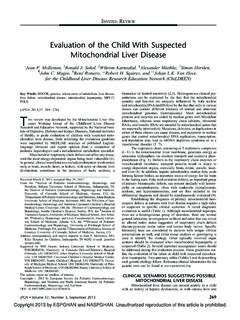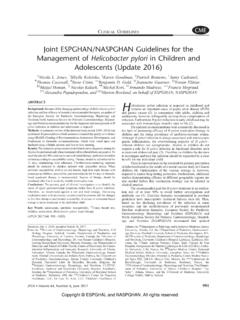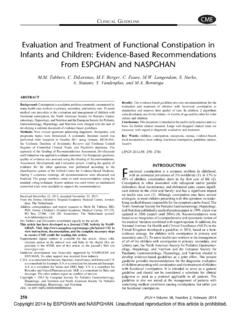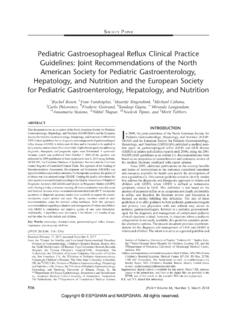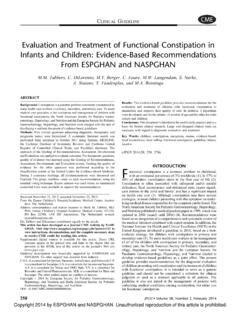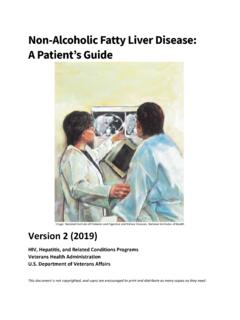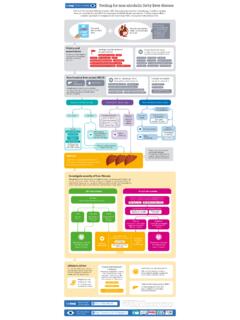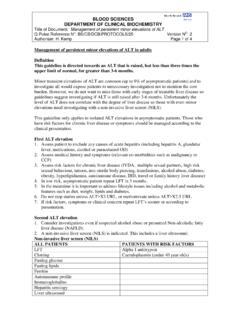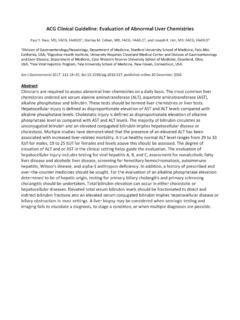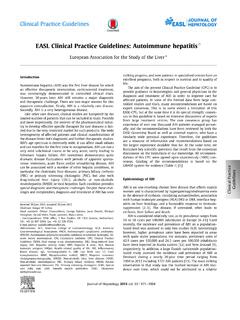Transcription of NASPGHAN Clinical Practice Guideline for the Diagnosis and ...
1 Copyright ESPGHAL and NASPGHAN . All rights Clinical Practice Guideline for the Diagnosisand Treatment of Nonalcoholic fatty liver Diseasein Children: Recommendations from the ExpertCommittee on nafld (ECON) and the North AmericanSociety of Pediatric Gastroenterology, Hepatologyand Nutrition ( NASPGHAN ) yMiriam B. Vos,z Stephanie H. Abrams,z Sarah E. Barlow,jjSonia Caprio, #Stephen R. Daniels, yyRohit Kohli,zz Marialena Mouzaki,jjjj Pushpa Sathya,## Jeffrey B. Schwimmer, #Shikha S. Sundaram, and yyStavra A.
2 XanthakosABSTRACTN onalcoholic fatty liver disease ( nafld ) is a highly prevalent chronic liverdisease that occurs in the setting of insulin resistance and increased adiposity. Ithas rapidly evolved into the most common liver disease seen in the pediatricpopulation and is a management challengefor general pediatric practitioners,subspecialists, and for health systems. In this Guideline , the expert committee onNAFLD reviewed and summarized the available literature, formulating recom-mendations to guide screening and Clinical care of children with Words:children, nonalcoholic fatty liver disease , recommendations,treatment(JPGN2017;64: 319 334)Nonalcoholic fatty liver disease ( nafld ) is a chronic liverdisease resulting from excessive fat accumulation in theliver.
3 Because of its close association with obesity, it has becomethe most common liver disease in children in the United can result in progressive fibrosis and lead to end-stage liverdisease. Within the last decade, it has become one of the leadingindications for liver transplantation in adults (1).Best practices in management of pediatric nafld are notclearly defined. A Guideline focused primarily on care of adults withNAFLD was released in 2011 (2). Recommendations addressingdiagnosis of pediatric nafld were published in 2012 (3);however, it did not include screening, treatment, and publichealth implications.
4 The North American Society of PediatricWhat Is Known Nonalcoholic fatty liver disease is a highly prevalentliver disease in children. Guidance is needed for Clinical care decisions forpediatric nonalcoholic fatty liver Is New The following recommendations are based on a formalreview and analysis of the recently published worldliterature (PubMed and EMBASE search through May2015),guidelinesfromothersocietieswhe napplicable,and the experience of the expert committee. Recommendations for Clinical Practice , includingscreening, Diagnosis , treatment, and public healthconsiderations are covered in this pediatric November 30, 2015.
5 Accepted November 22, the School of Medicine, Emory University, theyChildren s Healthcareof Atlanta, Atlanta, GA, thezTexas Children s Hospital, the Baylor Collegeof Medicine, Houston, TX, thejjSchool of Medicine, Yale University, NewHaven, CT, the School of Medicine, University of Colorado, Denver, the#Children s Hospital Colorado, Aurora, CO, the Cincinnati Children sHospital Medical Center, theyyDepartment of Pediatrics, University ofCincinnati, Cincinnati, OH, thezzHospital for Sick Children, the Schoolof Medicine, University of Toronto, Toronto, thejjjjJaneway Children sHealth and Rehabilitation Centre, the Discipline of Pediatrics, Faculty ofMedicine, Memorial University of Newfoundland, St.
6 John s, NL, Canada,the##School of Medicine, University of California San Diego, and the Rady Children s Hospital, San Diego, correspondence and reprint requests to Miriam B. Vos, MD, MSPH,FAHA, School of Medicine, Emory University, 1760 Haygood Dr, Atlanta,GA 30322 (e-mail: project was funded by the North American Society of Pediatric Gastro-enterology, Hepatology and Nutrition ( NASPGHAN ) and grants DK096157,DK61731, and DK107243 ( ) and DK088925, DK088831, andDK61734 ( ). The content is solely the responsibility of the authorsand does not necessarily represent the official views of NASPGHAN or theAAP.)
7 This project was endorsed by the American Academy of has research funding from Resonance Health Inc, serves on a DSMB forAegerion, and as a consultant for Shire, Immuron, Intercept, and TargetPharmasolutions. serves on a DMC for Novo Nordisk and consults forSanofi. has research funding from Raptor. The remaining authors reportno conflicts of #2016 by European Society for Pediatric Gastroenterology,Hepatology, and Nutrition and North American Society for PediatricGastroenterology, Hepatology, and NutritionDOI: Volume 64, Number 2, February 2017319 Copyright ESPGHAL and NASPGHAN .
8 All rights , Hepatology and Nutrition ( NASPGHAN ) com-missioned the Expert Committee on nafld to address this committee included specialists in general pediatrics, hepatol-ogy, gastroenterology, nutrition, cardiology, endocrinology, andpediatric obesity following recommendations are based on a formalreview and analysis of the recently published world literature(PubMed and EMBASE search through May 2015), guidelinesfrom other societies when applicable, and the experience of theexpert committee.
9 These guidelines are intended for pediatricians,allied health professionals caring for children, pediatric gastroen-terologists, hepatologists, endocrinologists, and preventive cardiol-ogists. They suggest preferred evidence-based approaches for theclinical care of children related to nafld but remain flexible andadjustable for individual patients and circumstances. In areas inwhich insufficient evidence existed, the committee drew on thecollective experience of the members to provide Grading of Recommendations, Assessment, Develop-ment, and Evaluation (GRADE) system was used to classify thequality of evidence and strength of recommendations (Table 1).
10 Thestrength of recommendation in the GRADE system is classified asstrong or weak. The quality of evidence for each recommendation ischaracterized as high, moderate, or low quality. The GRADE system assesses the quality of evidence available. Specifically, itevaluates the methodological limitations of studies, whether theresults of different studies are consistent or generalizable, andwhether treatment approaches have been found to be effective( ). In this Guideline , the term children includes 0 to 18 fatty liver DISEASEDEFINITION AND SUBGROUPSP ediatric nafld is defined as chronic hepatic steatosis inchildren (18 years or younger), which is not secondary to genetic/metabolic disorders, infections, use of steatogenic medications,ethanol consumption, or malnutrition.


